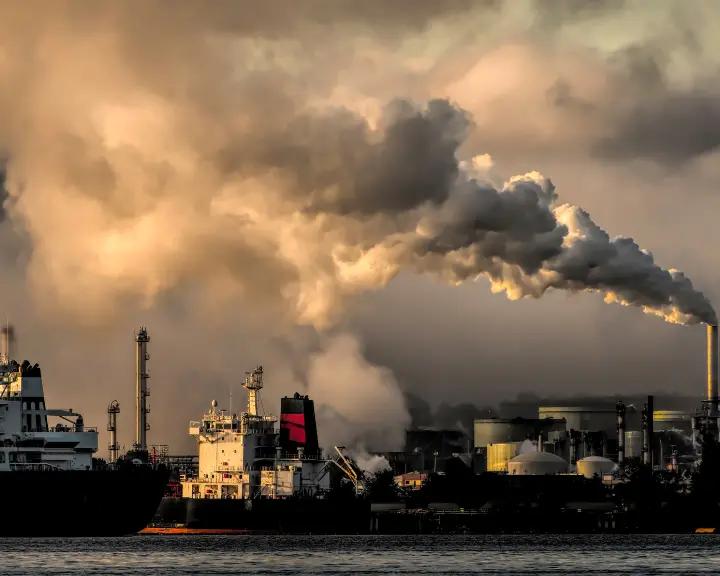Seamlessly integrate your TMS, ERP or any other platform in your ecosystem with your customers, partners, or software vendors, so you can offer CO2 data and stay ahead of SEC regulations.
Carbon Footprint Supply Chain
The carbon footprint supply chain accounts for more than 90% of the impact on air, land, water, biodiversity, and geological resources than any other industry. Long before COVID-19, a report by McKinsey found that a typical consumer company’s supply chain has social and environmental implications that cost far more than the expenses of their own operation. Supply chain and climate change have gone hand in hand ever since the impact of harmful emissions was discovered. In 2021, only eight global supply chains were found responsible for more than 50% of annual greenhouse gas emissions.
So what are supply chain emissions, exactly? Emissions released in the supply chain process are usually what many call “greenhouse gasses” or carbon dioxide released into the environment from supply chain activities. Supply chain emissions are mostly from travel since carbon dioxide emissions/CO2/greenhouse gasses result from burning fossil fuels such as coal, gas, and oil. Freight shipping can use up a lot of gas as products and materials must be shipped around the world. Many products and materials are also transported by plane, which emits 100 times more CO2 per hour than a shared form of road transportation.
There are also multiple classifications of supply chain emissions. They are known as Scope 1, 2 & 3 emission. The definition of all scope emissions is unique to the scope. There is also a fourth category, Scope 4 emissions.
Scope 1 emissions are also called direct emissions and they result from company-owned and controlled resources. Examples of Scope 1 emissions include emissions from company facilities and company-owned personal vehicles but not product transportation and distribution. Scope 1 emissions are further subdivided into four categories: stationary combustion, mobile combustion, fugitive emissions, and process emissions.
Scope 2 emissions are indirect emissions from the generation of purchased energy from a utility provider. For example, Scope 2 emissions are the greenhouse gasses released into the atmosphere from electricity, steam, heat, and cooling that were acquired from a power plant.
Scope 3 emissions are what most would think of when discussing the carbon footprint in supply chain management. Scope 3 emissions are separated into 15 categories, most of which we’ll cover in the next section. Scope 3 emissions are defined as all indirect emissions related to company activities, including both upstream and downstream emissions. While Scope 1 and 2 emissions are mandatory to report, while Scope 3 is voluntary.
Scope 4 emissions are also called avoided emissions. Avoided emissions have been defined as emission reductions that occur outside of a product’s lifecycle but as a result of the use of the product. A popular example of avoided emissions is the use of teleconferencing services that enable people to work remotely. People who use teleconferencing systems to work remotely would otherwise have had to commute to an office, likely using vehicles that emit greenhouse gasses. But instead, the employees work remotely, reducing emissions. The projected emissions reduced are Scope 4 avoided emissions for the provider of the teleconferencing equipment.
Supply Chain Emissions Scope 3
Even though Scope 3 emissions are voluntary to report and difficult to monitor, organizations have the most to make up for in terms of sustainability in these types of supply chain emissions. Scope 3 emissions are broken into 15 categories of both upstream and downstream emissions.
Upstream emissions are emissions created in order to produce the product, and downstream emissions are created in order to consume your product. Scope three carbon emissions examples of upstream emissions are activities such as business travel, employee commuting, and waste generation. Waste disposal is a particular target of green supply chain practices, as there is typically the most room to improve. Traditional methods of waste disposal emit methane gas and nitrous oxide, which cause greater damage than carbon dioxide emissions. Purchased goods and services are a catch-all category for upstream emissions from the production of goods and services purchased by the company in the same year. Transportation and distribution (supply chain) appear in both upstream and downstream emissions. Fuel and energy-related activities in Scope 3 are emissions relating to the production of fuel, energy purchased, and energy consumed that are not applicable to Scope 1 or 2. Capital goods is another category of upstream emissions. These are products that are meant to last a long time and are used by the company to create a product, provide a service, or assist in the sales process of storage or delivery. Examples of capital goods are buildings, vehicles, and machinery.
Examples of downstream activities include investments, franchises, leased assets, use of sold products, and end-of-life treatment, also known as waste generated during operations. While not all these activities directly relate to the supply chain, emissions Scope 3 encompasses have the biggest impact on greenhouse gas release.
While not every industry reports Scope 3 emissions, reports of scope 3 emissions by industry show the highest scope 3 emissions in the energy/power generation sector. In an attempt to encourage more organizations in more industries to report their Scope 3 emissions and move towards sustainability, the Scope 3 GHG protocol was developed. The Scope 3 Standard provides a method for businesses to use that can account for and report emissions from their operations.
Supply Chain Carbon Footprint Calculator
It can be difficult to manually calculate the carbon footprint of shipping and distribution activities. That’s why supply chain carbon footprint calculators have been developed - to assist businesses in accurately measuring their carbon footprint. If you’ve been wondering how to calculate GHG emissions, wonder no more - there is a simple EPA carbon footprint calculator for businesses that can take the guesswork out of the calculation and move towards a more automated and scalable solution. Many calculators also know how to calculate GHG emissions from KWH, so no one has to manually convert KWH to GHG any longer.
The formula for calculating greenhouse gas emissions is .0001 multiplied by fuel usage, multiplied by high heat value, and multiplied by an emission factor. While some organizations choose to calculate their own GHG manually, some of the best carbon footprint calculators are available online and can save a business a lot of time and money. The EPA carbon equivalent calculator allows businesses to convert emissions or energy data to the equivalent amount of CO2 emissions from using that amount. A few other carbon footprint calculators are the CoolClimate Calculator, the WWF Footprint Calculator, the Conservation International Carbon Footprint Calculator, and the TerraPass Carbon Footprint Calculator.
What is Supply Chain Decarbonization
Many industries are making an effort to reduce supply chain carbon footprint by investing in decarbonizing supply chain efforts and enhanced carbon monitoring. What is supply chain decarbonization? Decarbonization is about reducing carbon dioxide emissions resulting from human activity, including industry, with the eventual goal of eliminating them. One way of doing this is transitioning to sustainable supply chain activities with the priorities of reducing and eliminating carbon footprints. Ever since the Paris Accords were set in 2015, many organizations began creating plans in an attempt to achieve net carbon neutrality by 2050. This also includes entire countries and governments, in addition to industries. Low-carbon supply chain efforts are meant to increase carbon net neutrality and contribute to a more holistic and sustainable supply chain moving forward.
An example of decarbonization is reforestation efforts. In order to achieve net carbon neutrality, corporations would need to plant trees or stop deforestation equal to the emissions that they are producing. Decarbonization is most effective when applied broadly to many business practices and processes. The goal of decarbonization is to remove CO2 equivalent emissions from the air, or at the very least, not add any more. Efforts to include more sustainable and eco-friendly practices into supply chains keep organizations compliant with their sustainable promises made under the Paris Act.
The Supply Chain Carbon Footprint Reduction Strategy
There are many ways that organizations are making supply chain decarbonization happen. For example, many large consumer companies have transitioned their delivery and transportation vehicles to electric or hybrid, consuming less fossil fuel and producing fewer GHG emissions. Transitioning to electric vehicles is just one example of the supply chain carbon footprint reduction strategy. How can manufacturers reduce their carbon footprint? Some other methods of reducing carbon footprint in the supply chain are to use “green” materials for manufacturing and construction, such as wood which is better for energy conservation. Improving energy efficiency through the use of LED lighting or HVAC upgrades is a simple way to reduce overall energy usage.
Many are concerned about the delivery and transportation of food items. The food supply chain emits approximately 13.7 billion metric tons of CO2e per year, which is more than one-third of all global emissions. How can we reduce the carbon footprint of the food supply chain? Transitioning to new methods of transportation, using more energy-efficient fuel, or switching to electric vehicles are some examples of methods to reduce the carbon footprint in the food supply chain.
One of the biggest factors necessary in making supply-chain decarbonization happen is the relationship and connection between supply-chain partners and logistics organizations. This is because reducing Scope 3 emissions require thorough visibility of supply chain activities from end-to-end, which can be very difficult to acquire and then communicate to others without the use of complicated software.
Carbon Data Integrations
In response to the declining climate, many organizations and countries created plans with decarbonization solutions with the goal of creating a net zero supply chain. The specific term net zero is important because, according to the Paris Agreement, net zero is where global warming stops. Creating a net zero procurement strategy requires a lot of collaboration with many logistics partners, which can be difficult to achieve without the use of complicated and expensive software.
That’s where Chain.io comes in. Chain.io can build integrations between the systems you already use and the systems that your partners use so that you can move towards sustainable practices. Chain.io also creates carbon data API and carbon data integrations so that you can easily keep track of your businesses’ Scope 3 emissions and plan for their reduction.
The use of carbon capture supply chain software is a method used to reduce carbon dioxide from the environment and achieve decarbonization in the supply chain. This is just one strategy used to reduce the carbon footprint of many logistics service providers and shippers in the supply chain. It can be very difficult for organizations to keep track of their supply chain carbon data, but with Chain.io carbon API and integrations, it’s an automated process that is scalable and contributes to reducing carbon emissions overall, moving towards the goal of sustainability and net zero emissions by 2050.
Many thought leaders are encouraging organizations to think of sustainability as a net-zero challenge: the supply chain opportunity. There is a lot of room for growth and improvement when it comes to Scope 3 emissions in many industries. Scope 3 emissions typically account for 80% of all emissions produced by a company. This report published in 2021 followed a similar report published in 2020 called the Net-Zero Challenge: Fast-Forward to Decisive Climate Action. These reports by the World Economic Forum detail the need for decarbonization and the efforts that many of the world’s industries have made thus far. With Chain.io, decarbonization efforts become accessible to businesses of many different sizes and industries, using the software and equipment they currently use to prioritize environmental supply chain management.







